Some of the most common caterpillars in North America are brown. They can have different light brown or dark brown nuances or combinations.
Other caterpillars are brown-red or brown-gray.
Some of these caterpillars mimic bird droppings while others mimic tree bark. These caterpillars may also use silk nets to protect themselves against predators such as wasps.
Most brown caterpillars live on the Eastern side of the US. This is a habitat with a diverse ecosystem with hosts such as hardwood trees, fruit-bearing trees, legumes, flowers, and other vegetables.
Caterpillars feed on tree leaves, plant leaves, or even on the root of legumes, unlike adult butterflies and moths.
Table of Contents
Are Brown Caterpillars Poisonous?
Brown caterpillars aren’t venomous or poisonous. They might have a bad taste, mainly by absorbing the toxins of their host plants.
These caterpillars are not poisonous to the plants they live on. Most caterpillars are detrimental through the eating damages they cause to the leaves, stems, or roots of their host plant.
In general, it’s best to avoid touching caterpillars. While most North American species aren’t poisonous, they might still cause dermatitis and skin rashes.
Brown caterpillars across the United States might have urticating hairs that cause skin rashes.
Only a handful of caterpillars in North America are poisonous. Most aren’t brown.
Hickory tussock caterpillars are known to be venomous, but these caterpillars are white.
Types of Brown Caterpillars
The following types of brown caterpillars are most common across North America.
1. Eastern Tiger Swallowtail Caterpillar
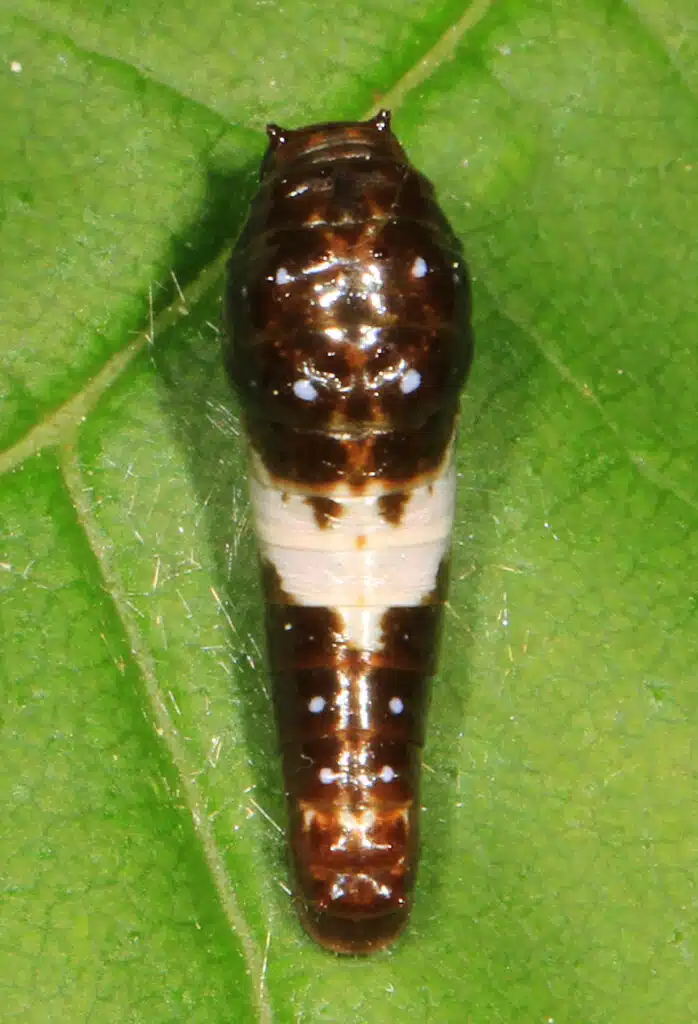
Eastern Tiger Swallowtail caterpillars (Papilio glaucus) are seen across diverse habitats. The species doesn’t have a single host plant or tree.
It can be found feeding on the leaves of roses or magnolias. These caterpillars are also seen feeding on the leaves of trees such as the tulip tree.
To a lesser extent in some areas, the caterpillar might also be seen on willow, ash, or hoptrees in Eastern North America.
The coloring of the caterpillar is mostly brown, up to the last instar when it turns green.
Eastern Tiger Swallowtail caterpillars have a brown color with bright underbellies for the first 3 instars.
2 eyespots are seen on the dorsal of the species, mainly associated with a defensive role.
This caterpillar can grow to a maximum length of 2.2 inches.
2. Pipevine Swallowtail Caterpillar
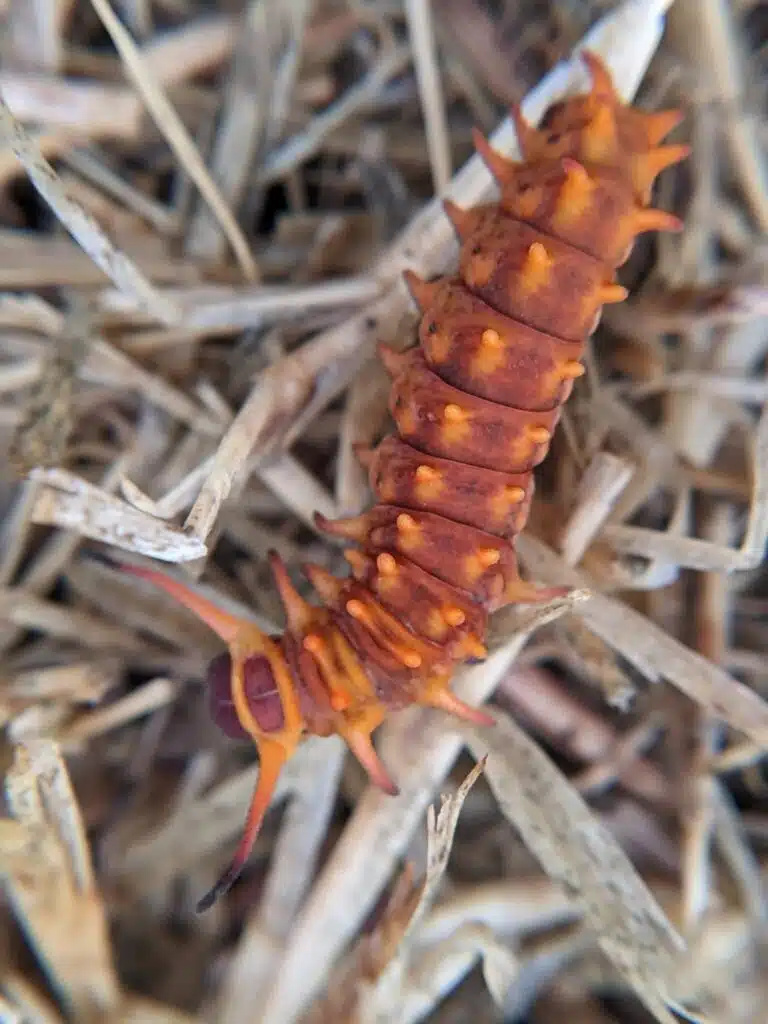
Pipevine Swallowtail caterpillars (Battus philenor) have a dark brown color in their late instars. This caterpillar grows to a size of up to 2 inches.
This species sometimes has dark brown-red coloring with light brown or red spots.
The species also has long filaments across the lateral sides of its body.
The name of the species is inspired by the hosts of the caterpillar. Tobacco-shaped plants in the Aristolochia family are its main host.
This caterpillar also used ginger and other plants as hosts. It absorbs toxins from these plants to have a bad taste to its predators.
Morning glories can also be a host species for the Pipevine Swallowtail caterpillar.
The brown caterpillar turns to a green pupa or it remains brown as a pupa as well.
3. Banded Woolly Bear
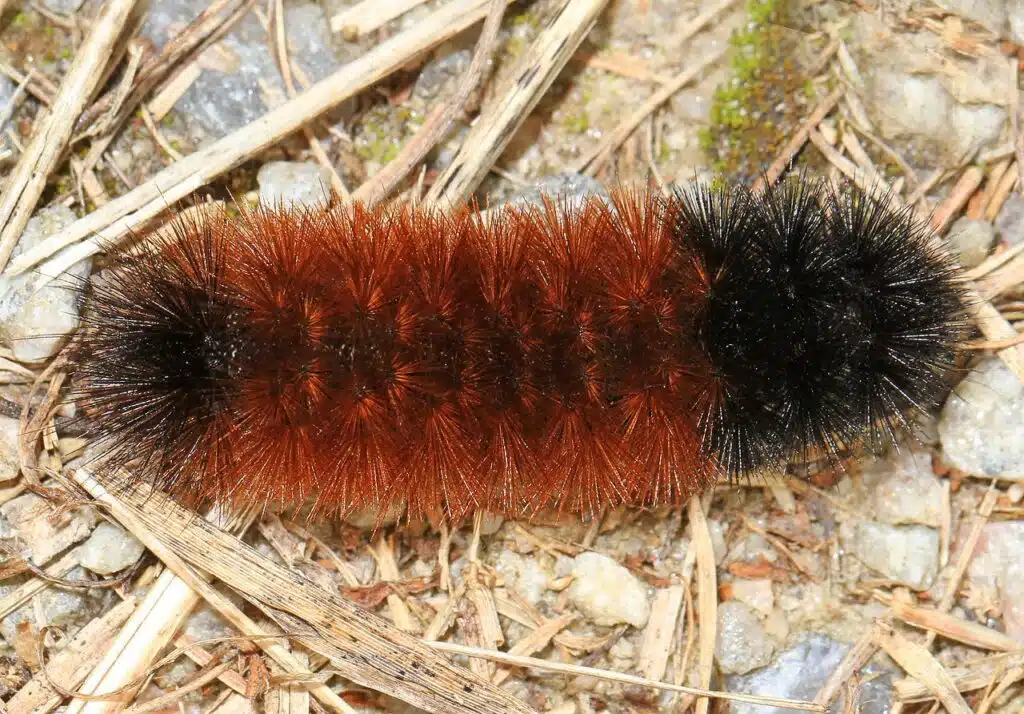
Banded Woolly Bear caterpillars (Pyrrharctia isabella) are known for having mostly brown coloring with additional black sections.
This caterpillar has sharp hairs which can be hurtful to the skin when directly handled.
There are no other consequences to touching these caterpillars apart from pain as their long sharp hairs aren’t venomous or poisonous.
Apart from the sharp hairs and brown colors, these caterpillars also stand out with their ability to overwinter.
This species is found in some of the Northern regions of North America which means it faces cold and freezing temperatures during the winter.
The larvae survive winters by freezing completely. Its vital organs are protected and it can spring back to life in the spring.
During the overwintering time, the heart of the Banded Wooly Beat caterpillars stops beating as it freezes.
4. Variegated Fritillary Caterpillar
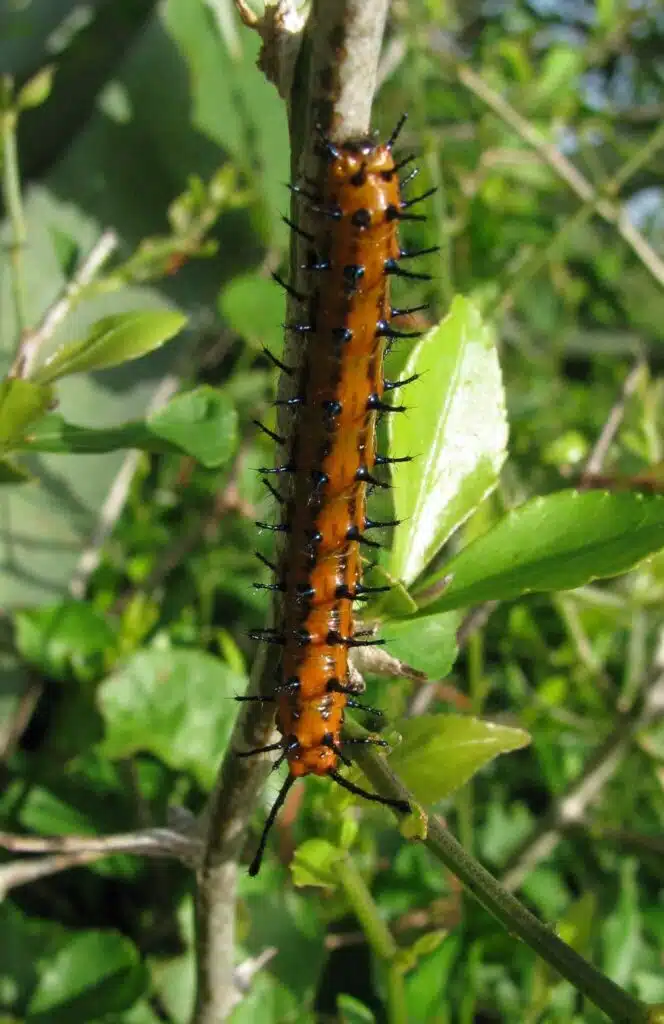
The caterpillar of the Variegated Fritillary (Euptoieta claudia) has multiple colors, including brown.
Long brown bands are seen across its body. Black and white stripes are also specific to this species, as are its long sharp black hairs.
This caterpillar changes color when it enters pupation to white and black.
Brown coloring is specific to the adult butterflies of the species as well. It retains the brown and black colors of the caterpillar on the dorsal wings.
Light brown and white sections are specific to the ventral wings of the Variegated Fritillary.
The caterpillar of the species is known to grow on plantain. However, there are at least 20 other plants this caterpillar has been spotted on.
Passionflowers, flax, and swallow-wort are just a few other hosts of the caterpillar.
Violets and passionflowers are some of the most common hosts of the Variegated Fritillary caterpillar in Southern US states.
5. Ailanthus Webworm Caterpillar
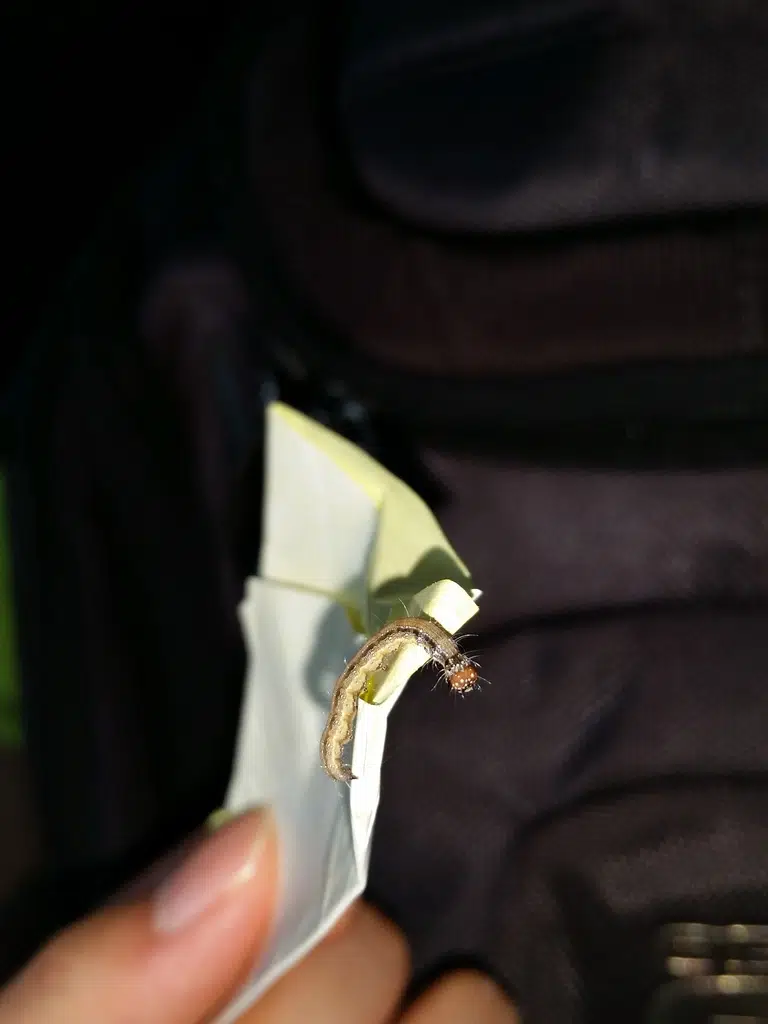
This genus of caterpillars (Atteva aurea) is native to Central and South America.
It’s identified by its brown or dark brown body with black being specific to its last instar. Small white or gray dots are seen on this caterpillar.
The species has an interesting history throughout North America as it jumped host species.
It uses Simarouba trees as hosts in Central and South America. These trees aren’t found in North America.
This species is believed to have made the most of the introduced species of tree of heaven, much more common in North America.
The caterpillar is considered a minor to medium-level threat as a pest to these introduced trees.
They invade trees in considerable numbers and build silk nets to keep predators such as wasps as far as possible.
6. Salt Marsh Caterpillar
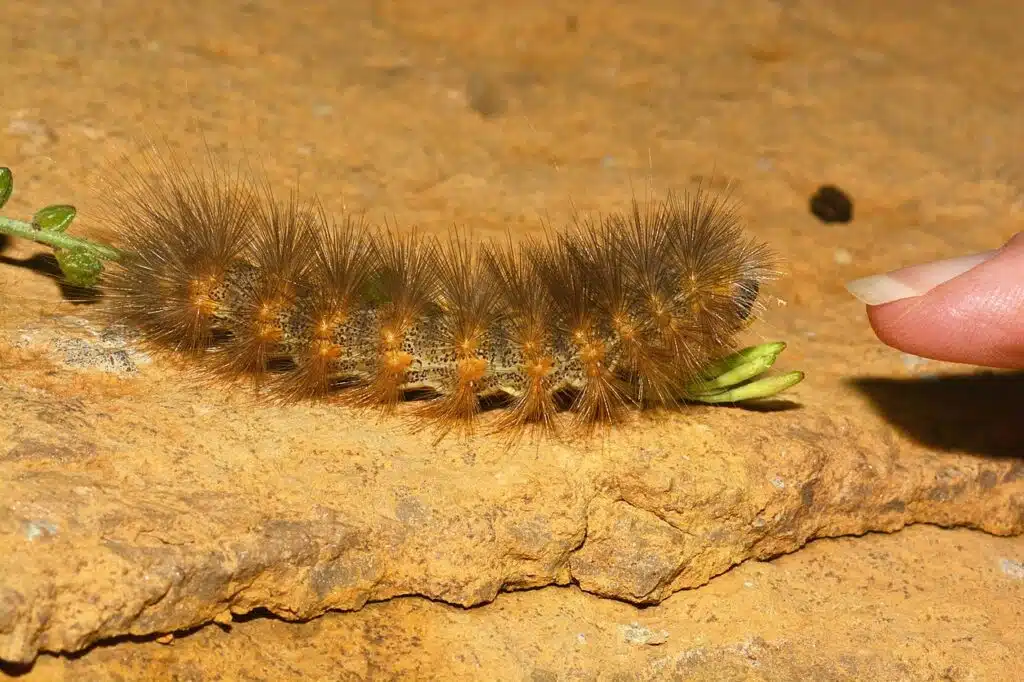
This caterpillar (Estigmene acrea) grows through different colors from one instar to another. It has a brown dominant color at first. It then changes to brown and yellow to finally be dark brown again as a mature caterpillar.
Salt March caterpillars are a bad sign in gardens and on crops.
These small caterpillars are known defoliators. They skeletonize legume leaves to levels where the entire vegetable stops growing.
They are seen on beans, asparagus, cabbages, and corn across North America.
This means the species affects some of the most common crops on the continent.
Without proper measures, this species can defoliate a large percentage of legumes in the garden as well.
These caterpillars are mostly impacted by tachinids.
Common North American predators of these species also include lady beetles, but to a lesser extent compared to tachinids.
7. Yellow Woolly Bear
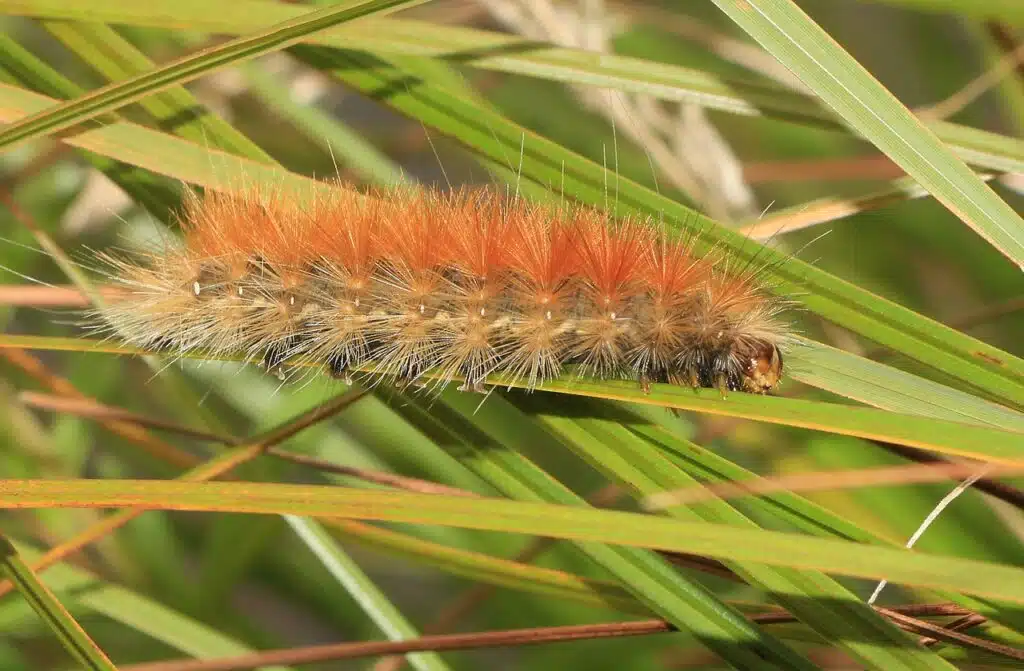
Yellow Wooly Bear caterpillars (Spilosoma virginica) come in different colors. This species is seen in multiple nuances of yellow or brown.
Yellow Woolly Bear caterpillars are a common garden and lawn pest, particularly in late summer when their numbers are the highest.
This species of caterpillars is known for its impact on low vegetation such as clovers.
It’s also known to defoliate various kinds of grass around the house and on the lawn.
The species has long brown or yellow hairs which aren’t poisonous but which may trigger skin rashes in some people.
Multiple Yellow Wooly Bear generations are seen per year. The final brood of a year is known to overwinter as a caterpillar.
It freezes but it doesn’t die completely as it springs back to life in the spring.
8. Western Tiger Swallowtail Caterpillar
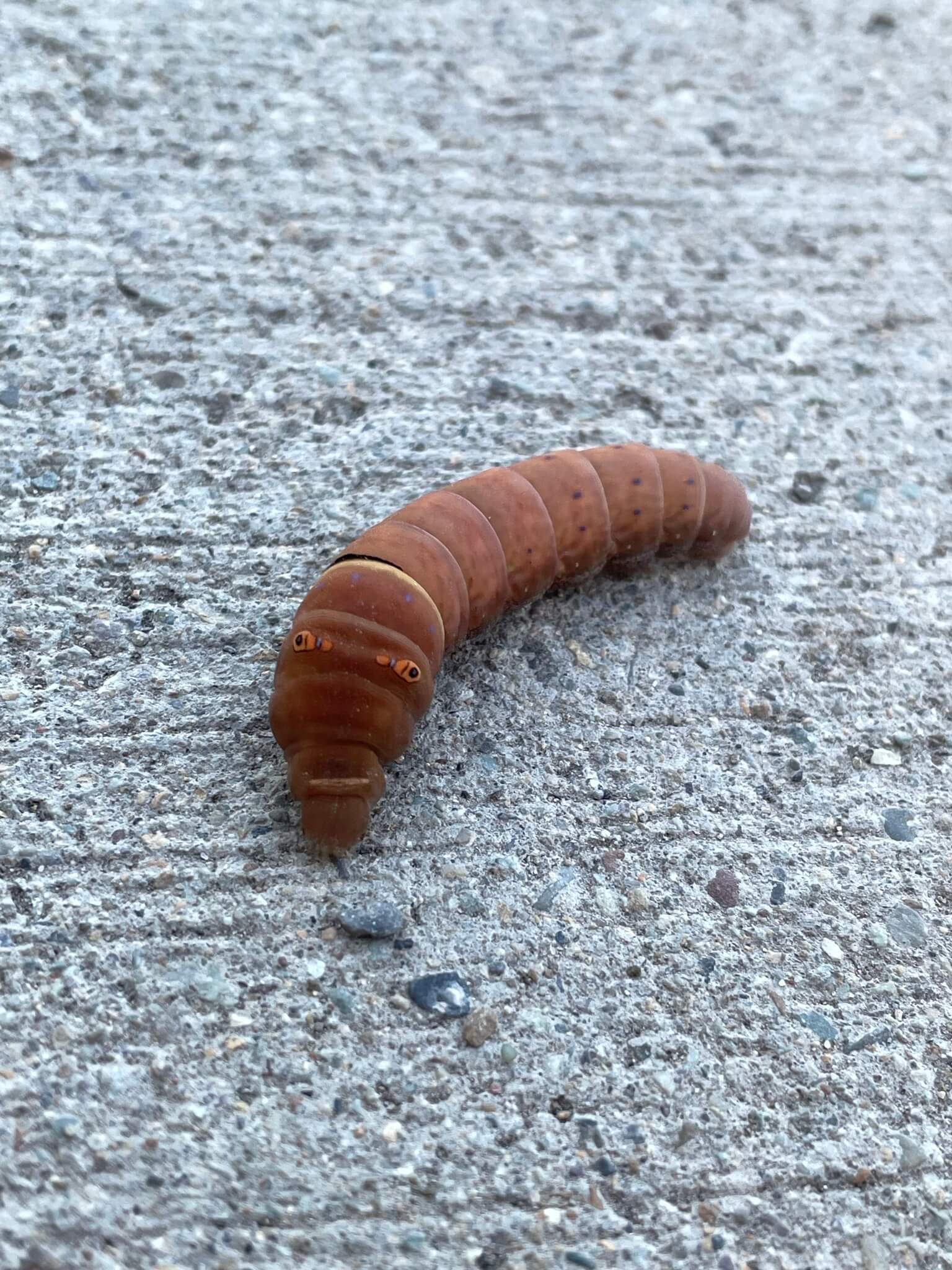
The Western Tiger Swallowtail (Papilio rutulus) is among the most common species of brown caterpillars in Western US territories.
This is a caterpillar known for its overall size as well. It can be among the few species that grow past 2 inches in length.
Initially, this caterpillar is only green. It then turns into a brown caterpillar with just a few yellow marks across its body before it pupates.
Western Tiger Swallowtail caterpillar is a common sight on willow, cottonwood, and on other similar tree species.
While dominant West of The Rocky Mountains, this species isn’t known for causing considerable damage to its host trees as true invasions are rare.
9. White-speck Moth Caterpillar
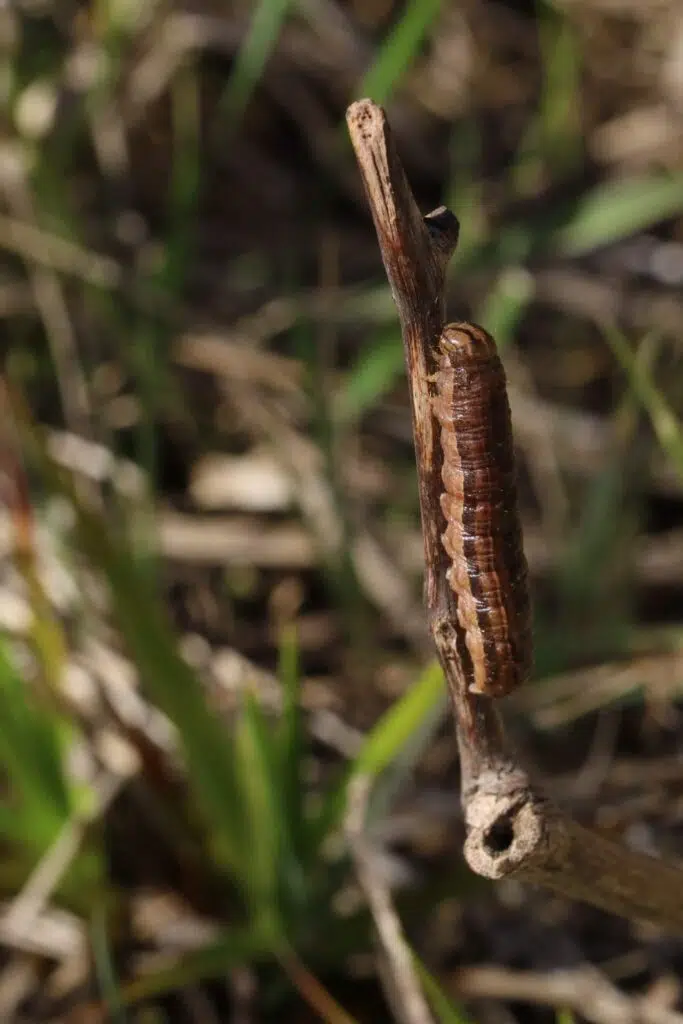
These types of caterpillars (Mythimna unipuncta) are mostly brown and gray. They are seen across multiple Northern and Southern habitats in the United States.
White-speck Moth caterpillars are known for using rice, maize, or cabbages as host species.
This means they can be seen as minor pests. They migrate to Southern territories to escape cold winters in the North which means they may affect crops across the country.
Caterpillars of this family are known for having at least 6 instars, compared to the 4-5 instars of other species.
In some cases, they can grow up to 30mm across 9 instars.
While rare, these 9 instar stages are characteristic of the caterpillars that grow in the coldest climates around the country.
They only maintain a pest status as a caterpillar.
Once the adult moth has pupated, it’s time for the species to move to fruit or nectar for food.
10. Large Yellow Underwing Caterpillar
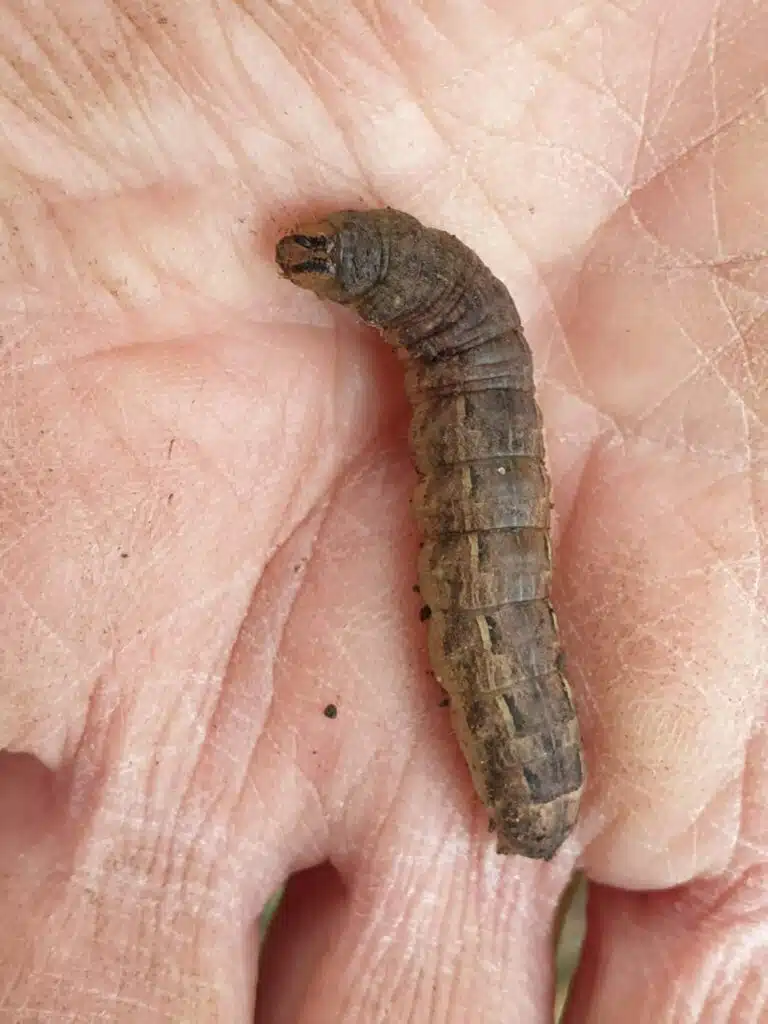
Caterpillars of this species (Noctua pronuba) grow to a maximum length of 50mm.
A brown body with gray bands and black spots is specific to this species while a green color is specific to the first instars of the caterpillar.
These adult Large Yellow Underwing also takes on some of the colors of the caterpillar as it’s mostly brown and gray, with yellow underwings.
This species is found on at least 20 host plants. Among them, wild carrots and beet prove to be preferred choices.
11. Little Wood Satyr Caterpillar
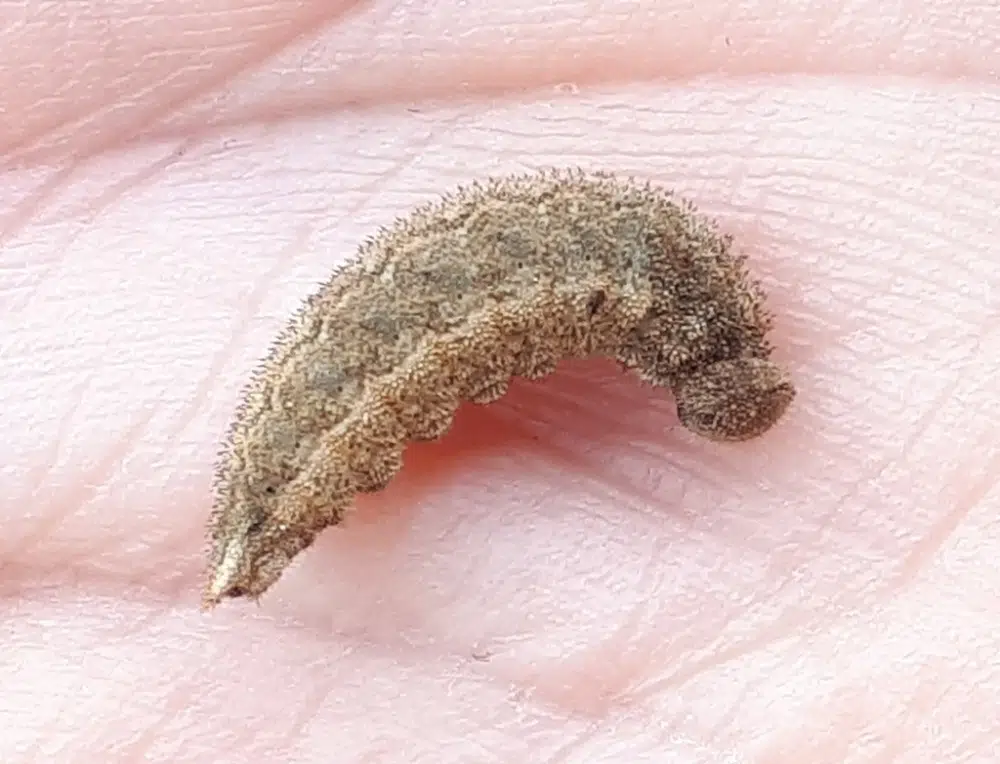
Caterpillars of this species (Megisto cymela) are a common pest of some of the most common lawn grasses. Centipede grass is one of the grasses the species is a pest for.
This type of caterpillar has a brown color which also translates to the coloring of the adult Little Wood Satyr. This butterfly is also brown.
Black and yellow eyespots are seen across the wings of the species, unlike on the caterpillar.
Only various shades of brown are specific to the coloring of the caterpillar.
This species is mostly seen across Eastern parts of the United States.
You might only see this caterpillar from May to June across the Northern states.
Caterpillars of this genus appear in 3 broods in Southern states where they can be seen from March to September.
Caterpillars of the species are easier to spot by their host grasses as adults feed on tree sap or even honeydew from aphids around the garden.
12. Wedgling Moth Caterpillar
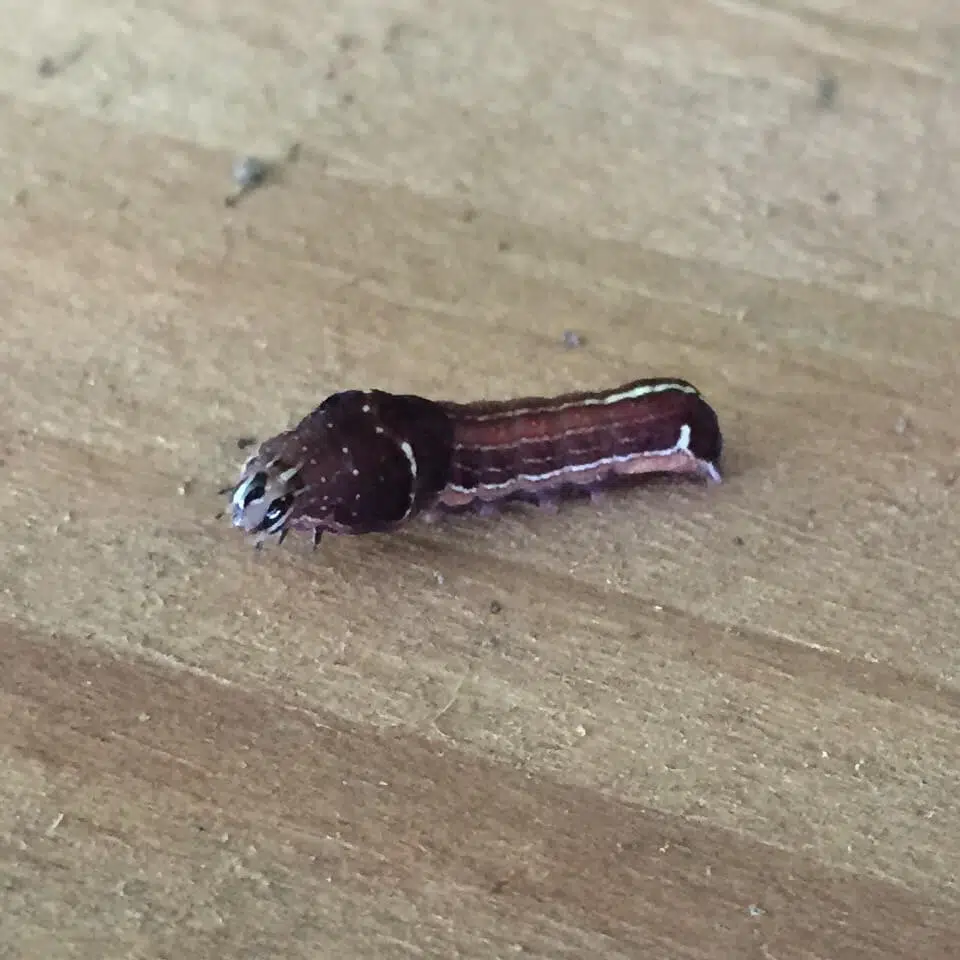
Wedgling Moth caterpillars (Galgula partita) have brown and dark brown coloring. This species has a combination of brown nuances plus white sections across its body.
Light and dark brown longitudinal stripes are seen on the species. The head of the caterpillar is dark brown, almost black.
The central white dorsal stripe is also seen on the species. A white stripe also separates the area of the head to the rest of its body.
These dark brown colors are also specific to the adult Wedgling Moth.
This species is found across a very wide habitat in the Eastern parts of North America.
It uses flowers such as stabwort and woodsorrel as hosts.
13. Common Tan Wave Caterpillar
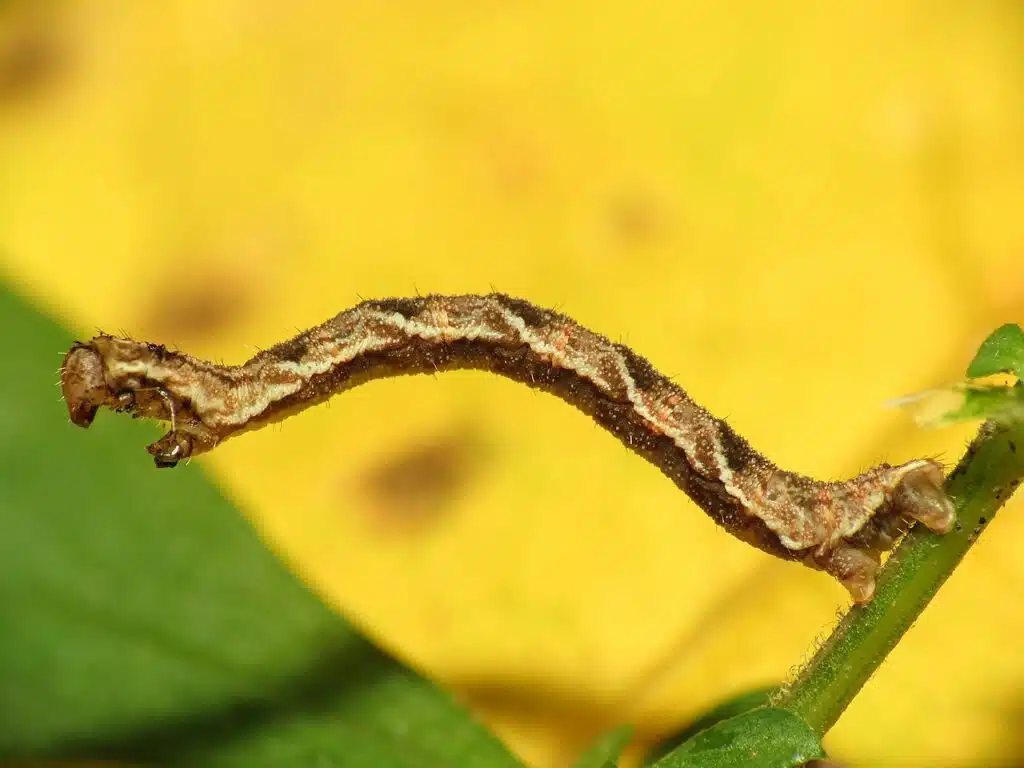
This caterpillar species (Pleuroprucha insulsaria) has light brown coloring. White sections separate the uniform brown color of the species.
Common Tan Wave moths maintain the tan and light brown colors specific to the caterpillar.
This species is known for its widespread North American distribution.
It lives on many host plants found in this part of North America.
Corn is one of the crops the caterpillar can invade. However, it has no significant impact on corn crops.
These caterpillars are also seen on a wide range of trees such as oak and chestnut.
Willows are also a highly common host tree for Common Tan Wave caterpillars.
14. Tulip-tree Beauty Caterpillar
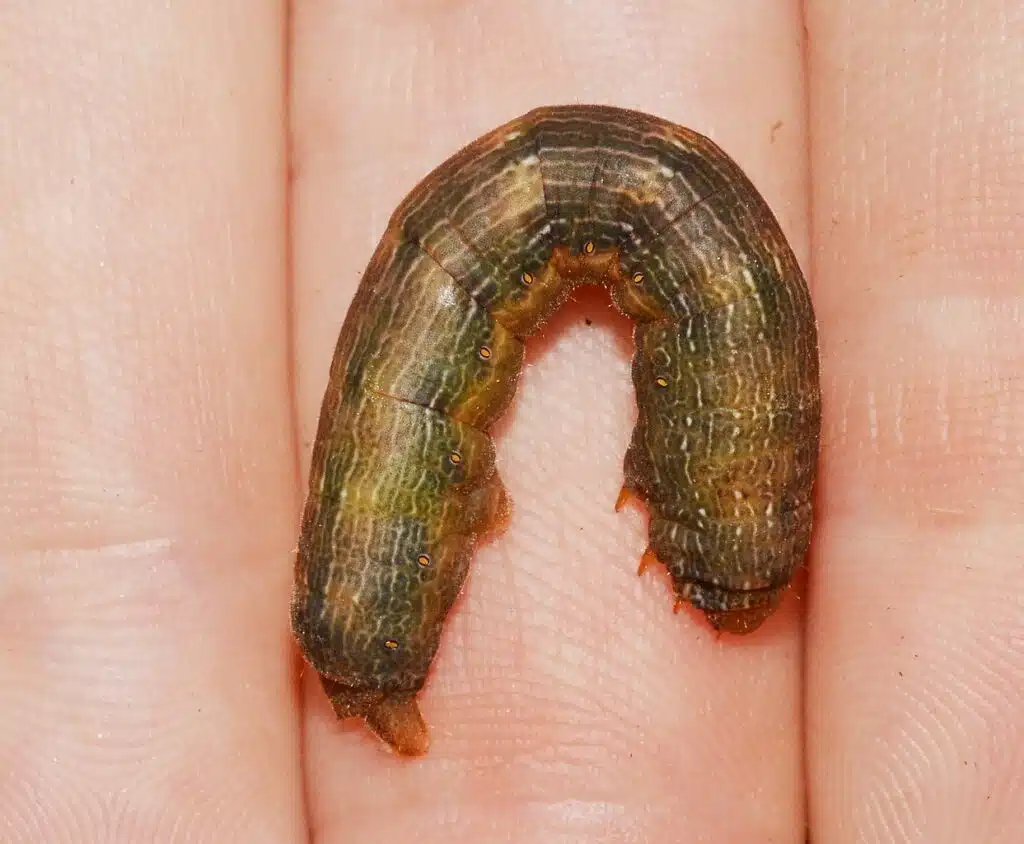
This species of caterpillars (Epimecis hortaria) are native to North America. It has a green coloring in its first instar turning brown as it matures.
Brown and gray colors are specific to this caterpillar. White or light brown coloring is seen on its ventral side.
As its name suggests, the species is mostly found on tulip trees in the United States.
It has also expanded its host species to poplar and a few other trees.
This caterpillar is also responsible for the coloring of the adult which has the same combinations of gray and brown nuances both on the dorsal and on the ventral wings.
This species is seen from spring to late autumn, depending on its region.
15. One-spotted Variant Caterpillar
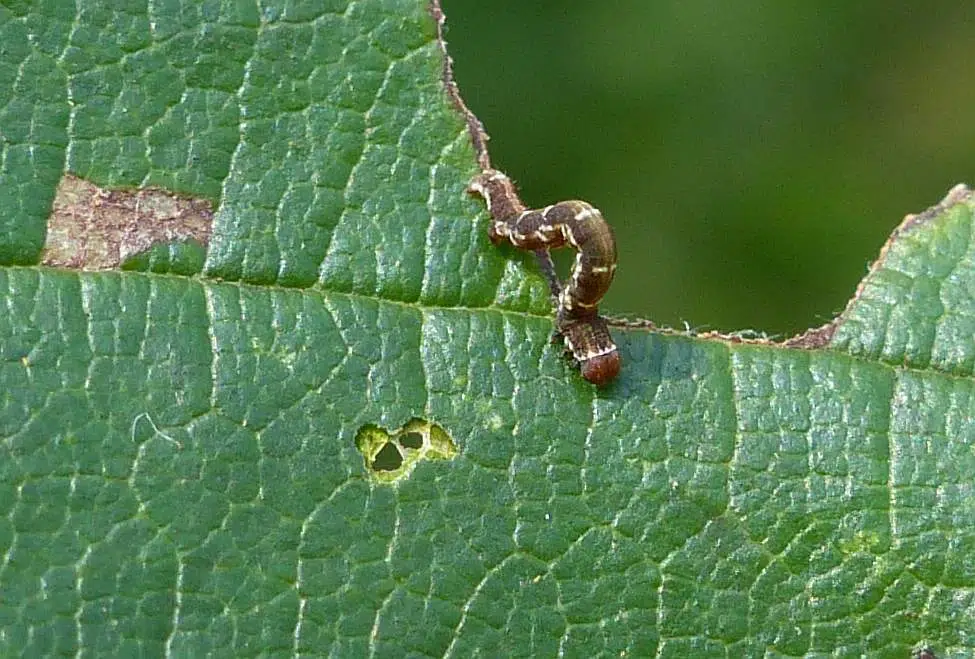
One-spotted Variant caterpillars (Hypagyrtis unipunctata) are among the species that mostly look like tree bark.
This species has brown and gray camouflage coloring which helps it remain undetected to predators.
It’s even shaped as a twig so that predators move along.
The adult of the species is also similarly colored.
Most of these caterpillars are found on the Eastern side of the United States, a large habitat benefiting from substantial rainfall.
This species is particularly common in areas around Missouri and New York.
16. Curved-toothed Geometer Moth Caterpillar
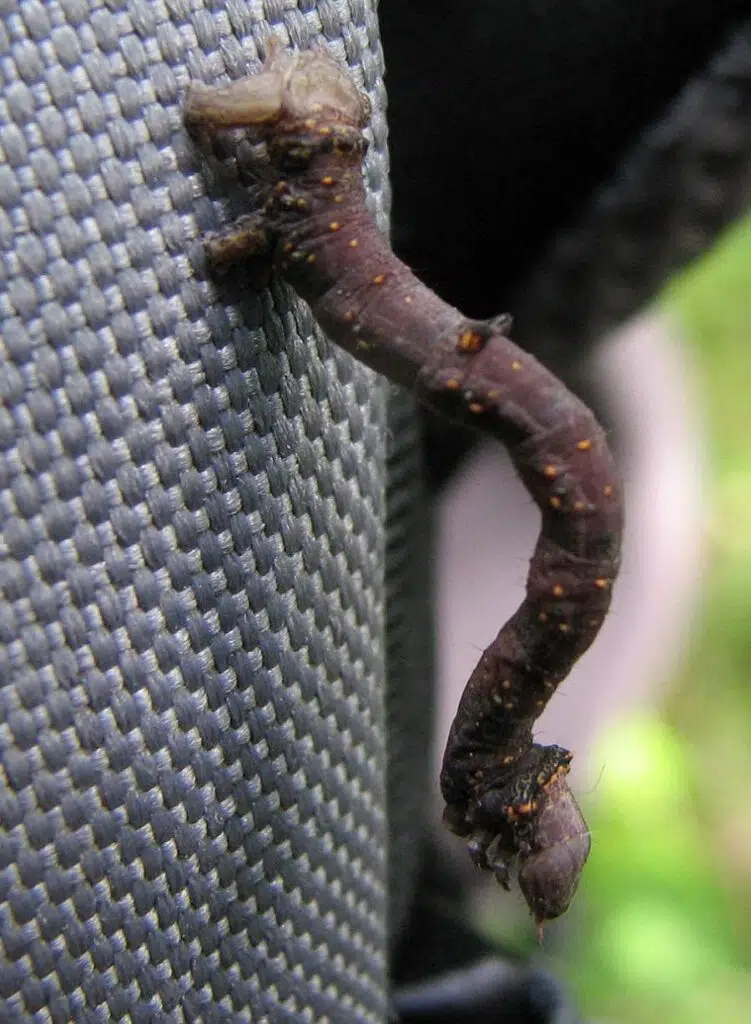
Twig-shaped Curve-toothed Geometer Moth caterpillars (Eutrapela clemataria) are also native to North America.
Caterpillars of this genus begin life as a brown species which slowly turns gray to mimic tree bark.
Its shape and color signal mimicry tactics are vital for the survival of the caterpillar and even of the adult which resembles dead leaves in coloring.
First seen in March, this species uses various trees as hosts.
Ash and birch are among the most common host trees of the species.
Other trees common in the US such as willow and even fir are seen as good hosts for this caterpillar.
It can be found in open areas, valleys, woodlands, and at high altitudes.
17. Bicolored Sallow Caterpillar
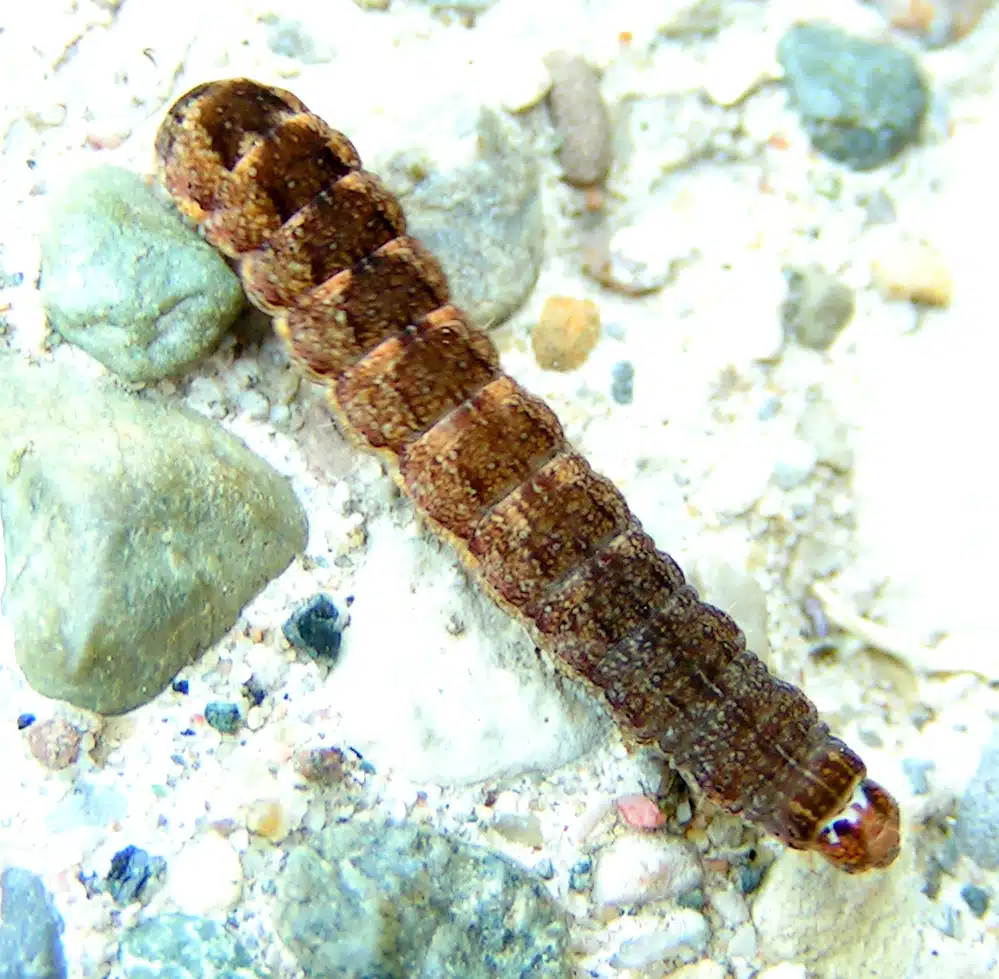
This species of caterpillars (Sunira bicolorago) has light brown and dark brown coloring. It’s among the species that only appear late in the season.
It starts to appear together with cabbages as it’s among the caterpillars that grow and eat cabbages.
This species is also seen on plum and tobacco leaves.
Cherry trees are also a common host for the bicolored caterpillar.
Its season starts late in the South and the North. This species continues flying until December in warmer states and only up until early November in Northern states.
18. Lunate Zale Moth Caterpillar
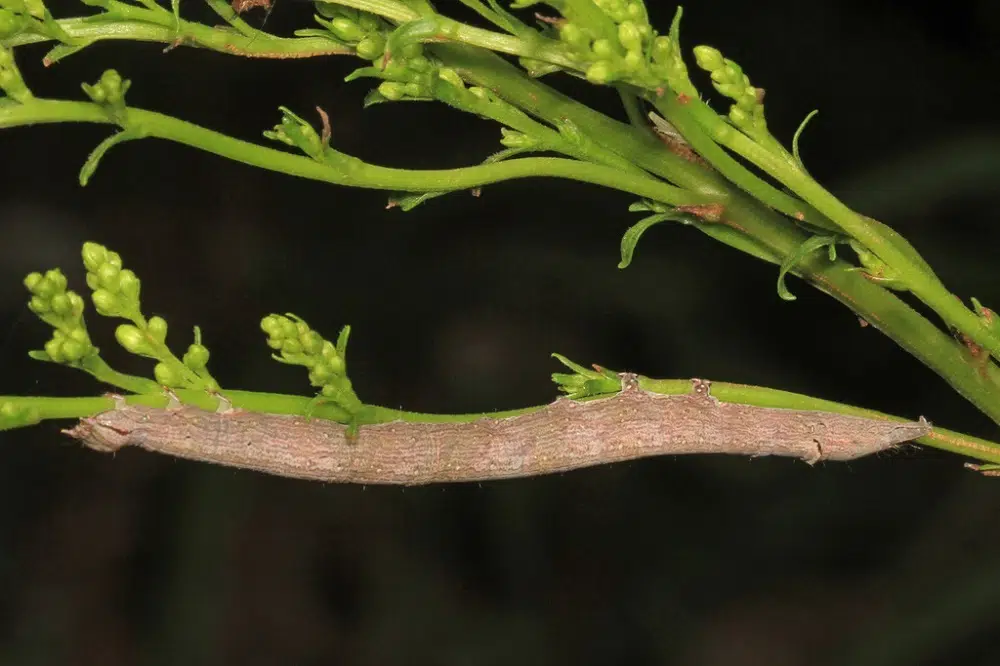
This caterpillar species (Zale lunata) begins life as a bright brown species. It then turns dark brown towards its final instar.
The species has a narrow elongated body which can make it resemble twigs.
Caterpillars of this genus are native to the US and are seen on a limited number of trees.
Apple, maple, and willow trees are among the host species of the caterpillar.
It can be found in parks, gardens, woodlands, and the edges of woodlands.
This species feeds on the leaves it grows on with minimum to no impact on tree health.
19. Porcelain Gray Caterpillar
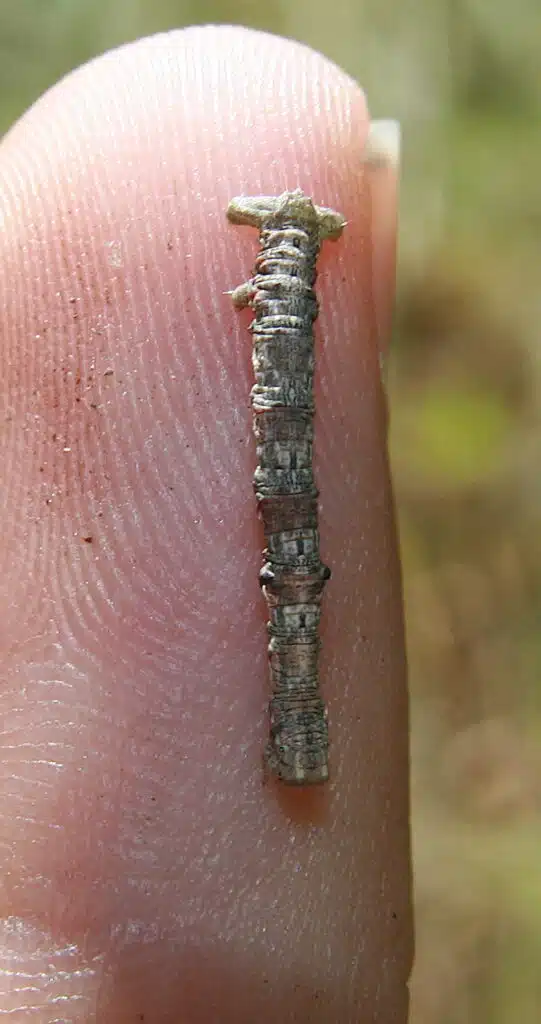
Caterpillars of this family (Protoboarmia porcelaria) begin life as a brown species. They slowly turn gray, similar to the color of tree bark.
They live from May to August-September and are found on a wide range of host plants and trees.
Juniper, red pine, and black spruce are among the most common hosts of the species.
The adherence to these hots makes the Porcelain Gray caterpillar a common sight at medium to high altitude, areas where pine grows.
The species can be detrimental to its host tree as up to 150 eggs are laid on a single tree.
20. Black Cutworm
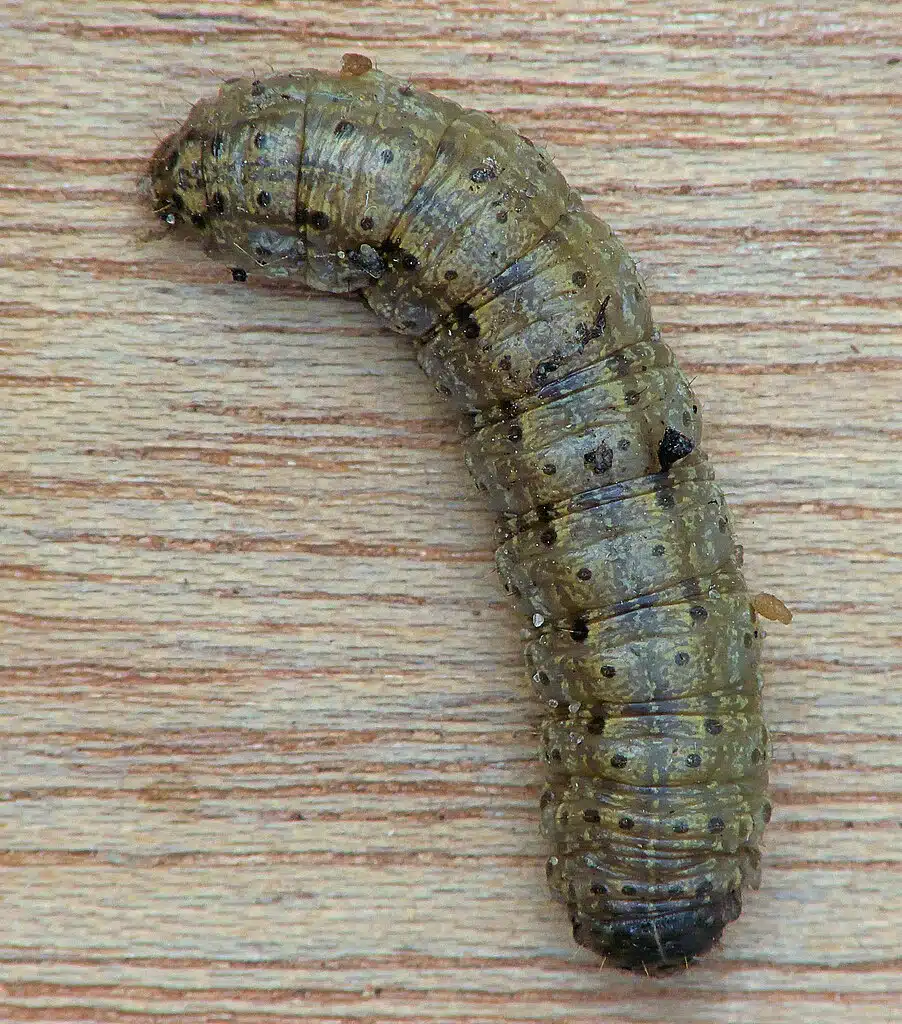
This species of caterpillars (Agrotis ipsilon) are identified by a combination of light brown and dark brown-tan colors.
It goes through multiple instars which dictate the exact brown nuances.
Black Cutworm caterpillars go through 5 to 9 instars, depending on their region and on the weather.
This species is one of the most prominent pests of crops across the continent.
The most problematic damages of the caterpillars are to the leaves and roots of plants. Alfafa and clover are among the main hosts of the species.
21. Pandorus Sphinx Caterpillar
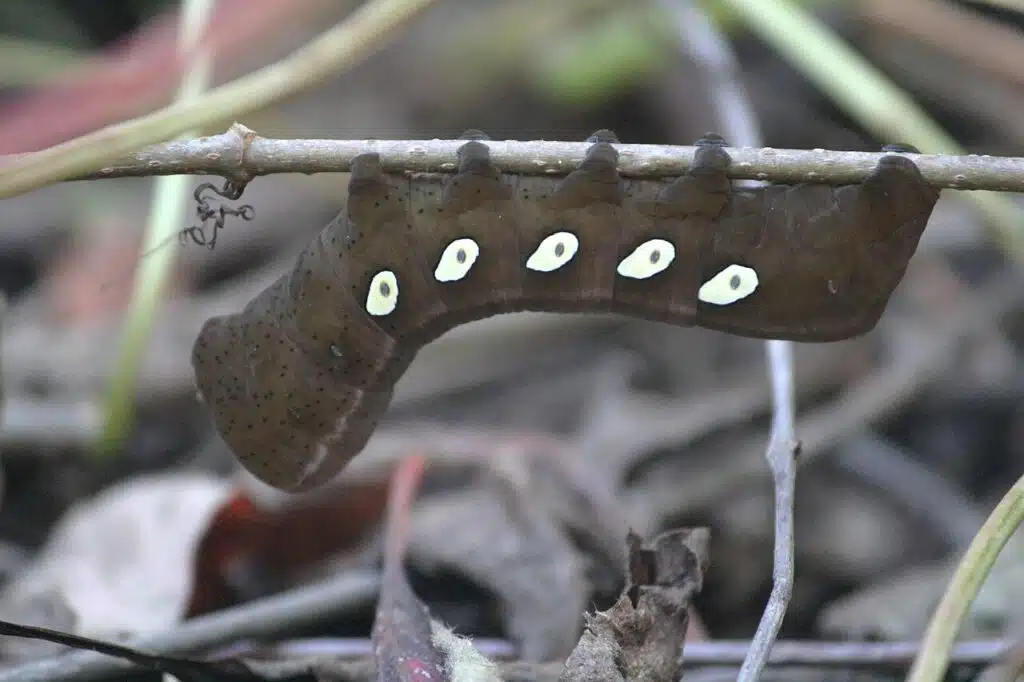
Pandorus Sphinx caterpillars (Eumorpha pandorus) are one of the few caterpillars with multiple eyespots across their body.
It has a brown-red uniform color.
5 large white and black eyespots are seen across the sides of its body.
These are self-defense mechanisms as the species uses contrasting eyespots to keep predators away.
Grapes and other vine plants such as Virginia Creeper are its main hosts.
This species is known to eat the leaves of various grapes in gardens. It then moves underground for pupation.
22. Black Witch Caterpillar
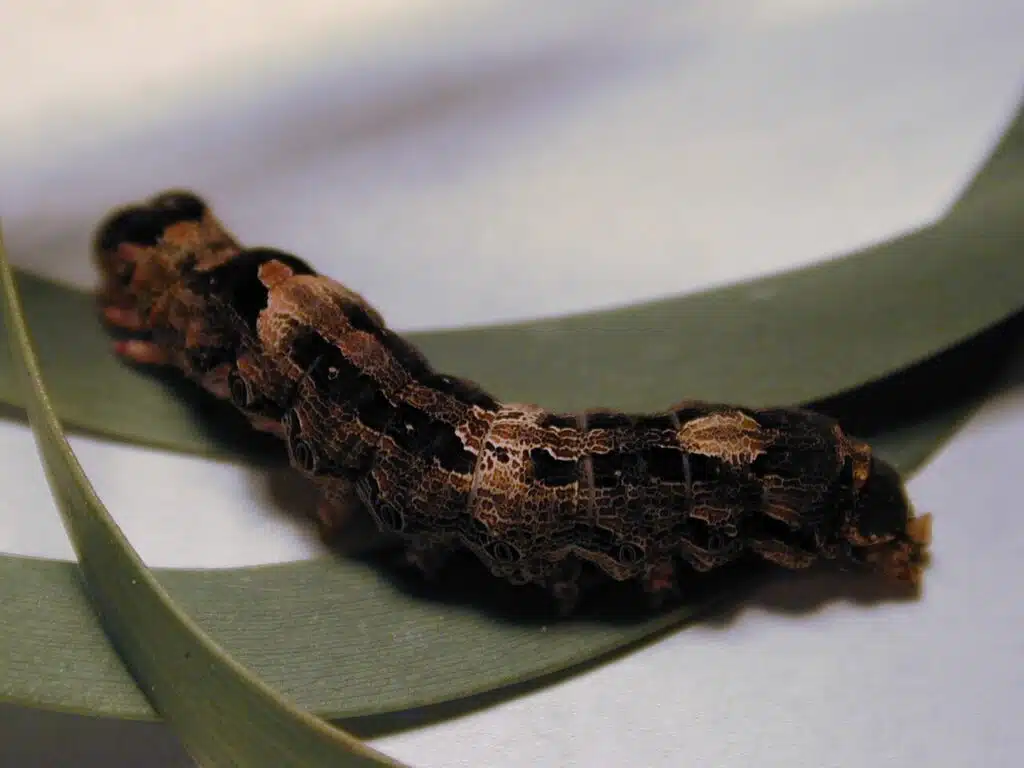
Black Witch caterpillars (Ascalapha odorata) mimic bird droppings so that they appear distasteful to their predators.
The species has light brown and dark brown coloring. Black spots are also distinguishable across its body.
This species is mostly found in Cassia flowers.
It’s among the species with the widest distribution in the United States. It lives in almost all states, including those on the West Coast.
The adult of the species is also light and dark brown. However, it doesn’t feed on flowers such as those from the cassia genus.
It feeds on tree sap and fruit.
23. Two-tailed Swallowtail Caterpillar
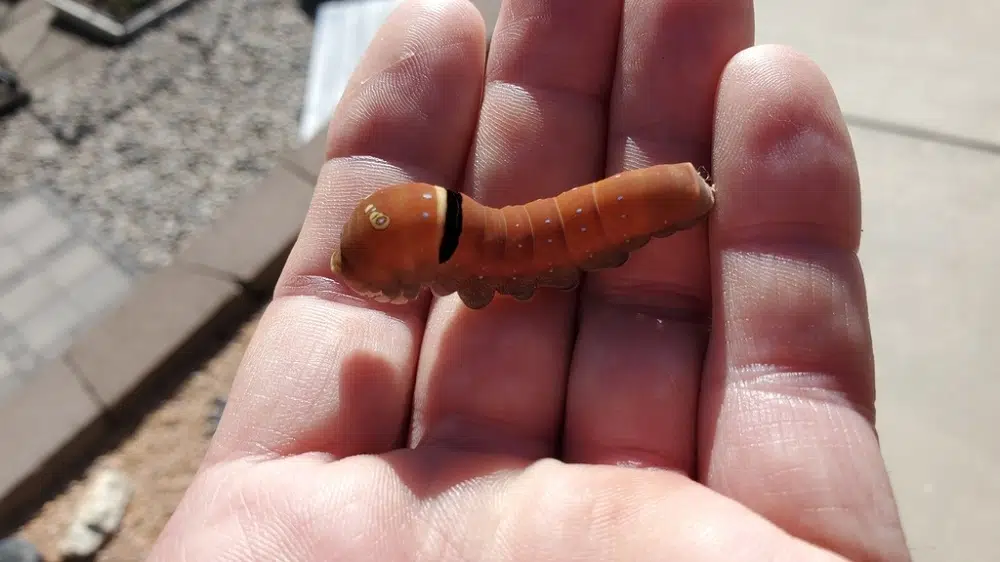
Two-tailed Swallowtail caterpillars (Papilio multicaudata) go through multiple color changes as they grow. These caterpillars are light brown turning dark brown and white as they grow.
These color combination and the patterns on the body makes the caterpillars appear similar to bird droppings.
You can find these caterpillars across the Western range of the United States.
They are native and common in California, Montana, and even Wyoming.
Ash trees are among the most common hosts of the species. This caterpillar feeds on tree leaves with the possibility of significant damage.
24. Dark-spotted Palthis Caterpillar
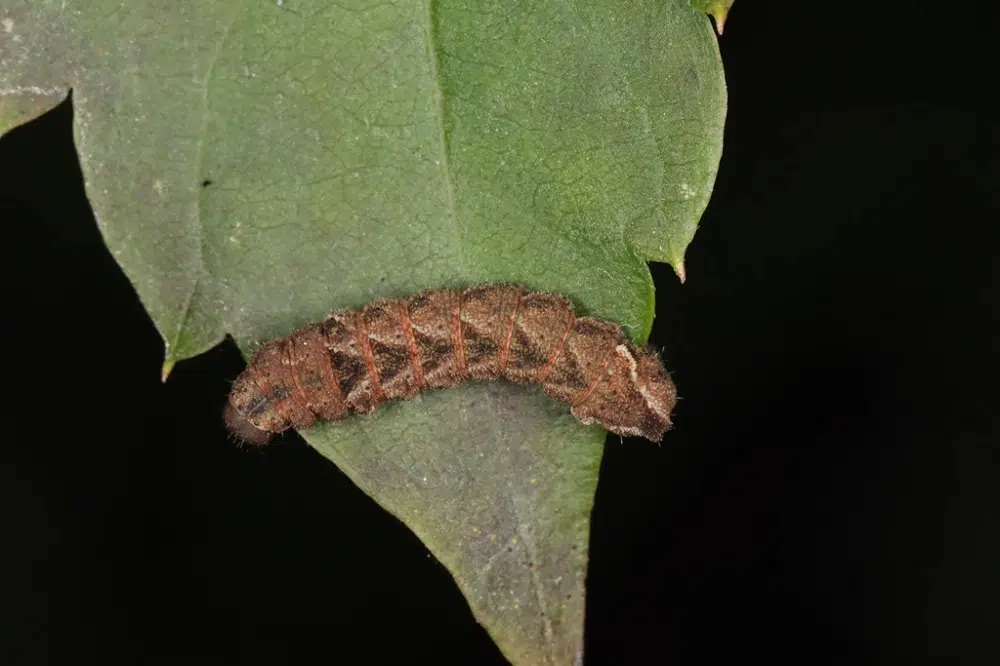
Dark brown coloring is specific to these caterpillars (Palthis angulalis). They have brown and black colors and irregular body shapes that mimic bird droppings.
This species is known for having different hosts such as birch and chestnut. It’s also present at higher altitudes where it can use fir and pine as its hosts.
Dark-spotted Palthis caterpillars are among the species which maintain their colors after pupation.
Light and dark brown Dark-spotted palthis moths of up to 26mm appear after pupation.
25. Juniper Geometer Caterpillar
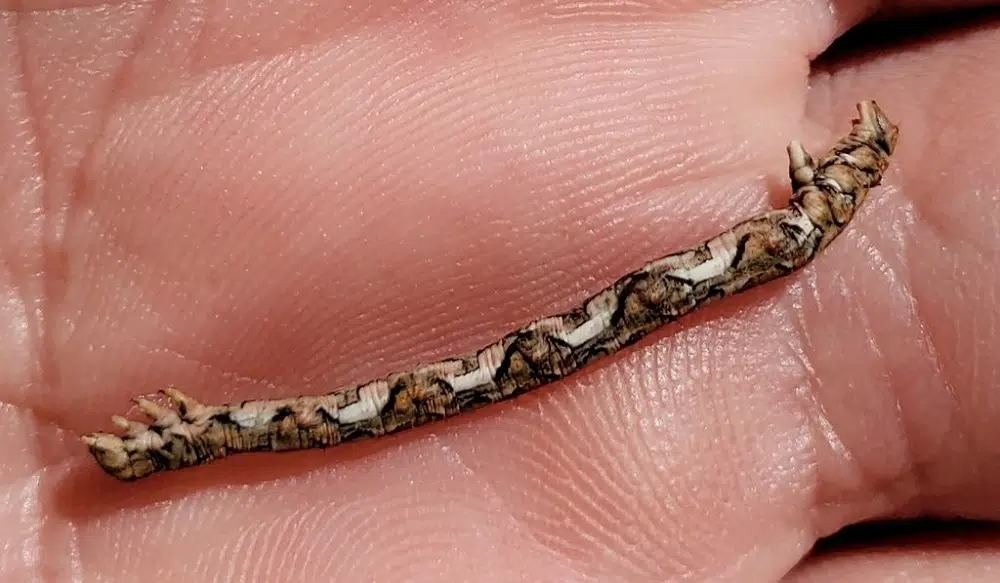
Juniper Geometer caterpillars (Patalene olyzonaria) are named after their juniper host.
An elongated thin body is specific to these caterpillars which have brown and white colors. Most of these caterpillars can be misidentified as twigs.
Mimicry coloring and shape specific to this species is their first self-defense method.
Multiple generations of these caterpillars are seen each year, up to November.
Adults emerge bearing similar light brown or tan colors. A dark brown band across the wings is also spotted on the adult Juniper Geometer caterpillar.
This species is endemic to Eastern parts of North America. It can be found from Vermont to Florida and Eastwards to Missouri.
26. Variegated Cutworm
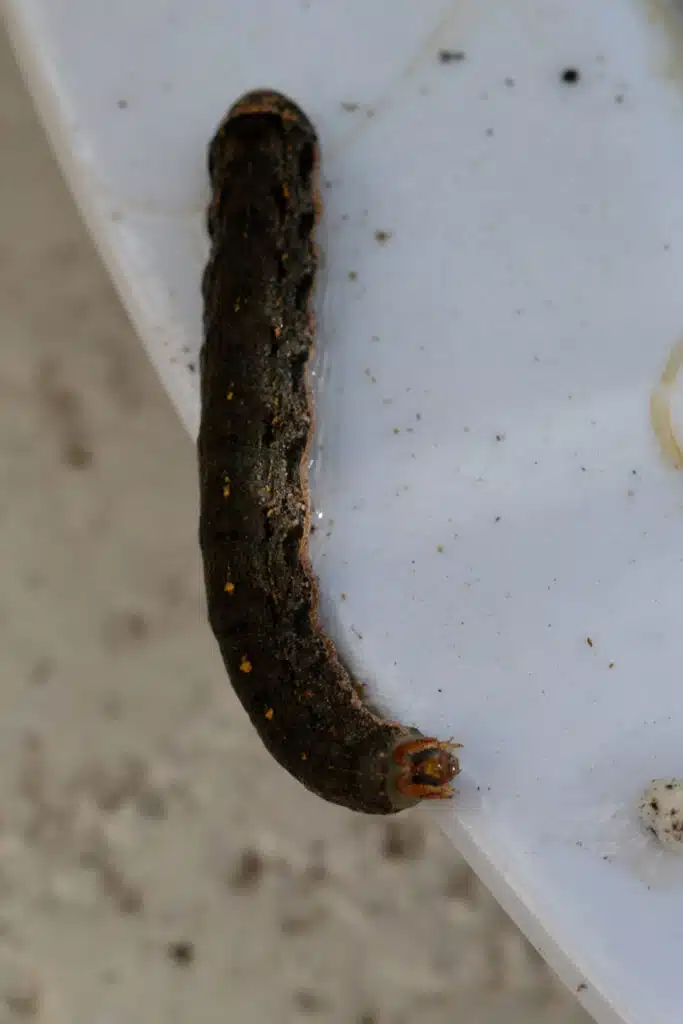
This type of brown caterpillar (Peridroma saucia) is considered a serious pest in gardens and greenhouses. It can feed on almost any type of legume with significant impact.
These caterpillars can kill legumes by consuming their leaves.
There are data to suggest the Variegated Cutworm lays eggs multiple times per year.
Multiple broods of this species are seen across North America. The number of these broods depends on their location.
Populations in Northern states and Canada tend to migrate South just before the winter where they can continue laying eggs up until November.
The last generation of caterpillar overwinters before emerging back in the spring and turning into a migratory adults.
27. Bronzed Cutworm
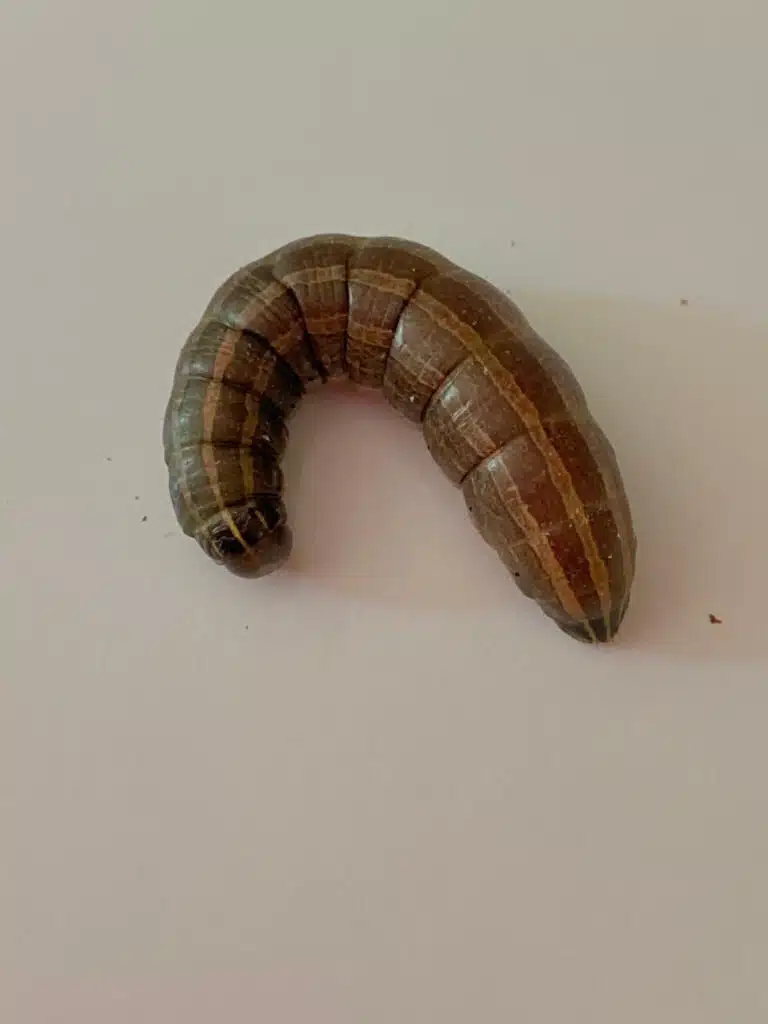
Bronzed Cutworm caterpillars (Nephelodes minians) are just as problematic as Variegated Cutowrm caterpillars to crops.
This species of caterpillars feed on various types of crops.
The species has brown and black colors. It has a short wide body and it can be found in gardens across Eastern North America.
The species is undergoing population and habitat growth.
Some populations of Bronze Cutworm have been reported in Western territories as well.
Cereal crops are a common sight for these caterpillars which tend to consume the leaves and roots of various kinds of cereal.
Corn crops across North America provide the ideal habitat for the species.
28. Horned Spanworm
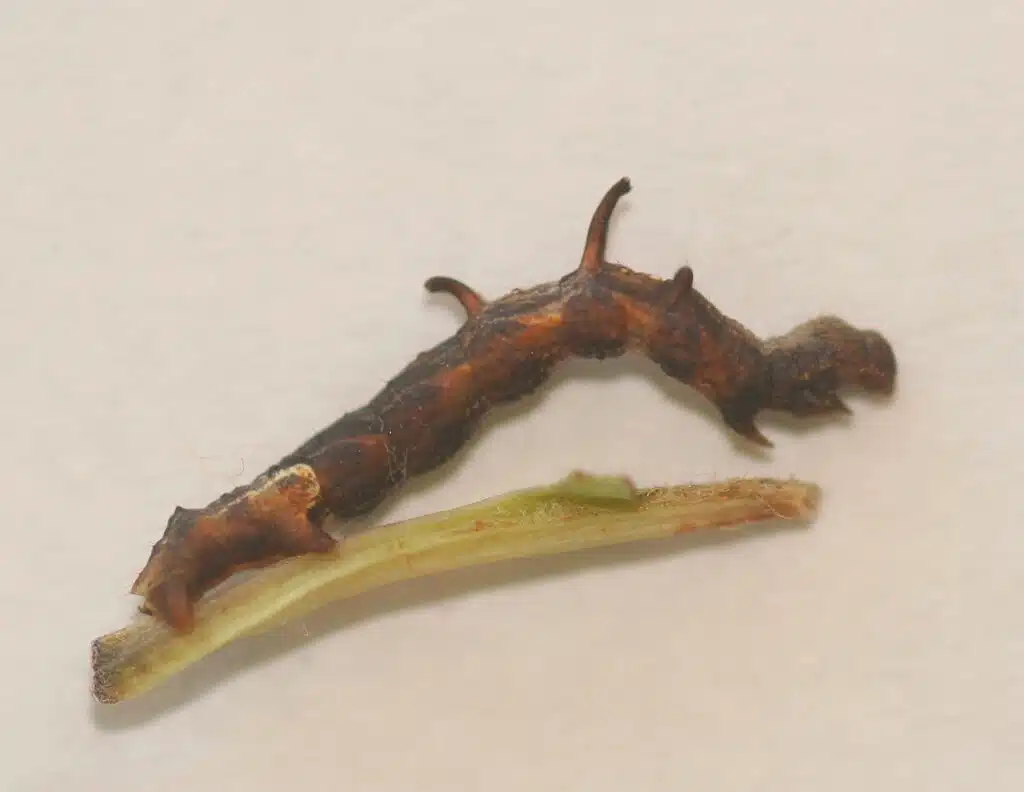
Horned Spanworm caterpillars (Nematocampa resistaria) have irregular body shapes with light brown and dark brown colors.
These caterpillars mimic various twigs, depending on their host tree or plant.
Horned Spawnworm caterpillars grow on fir, pine, and shrubs such as blueberry.
The species can show different color adaptations according to its host plant.
Some Horned Spanworm caterpillar morphs might even be gray.
Most common in forests, this caterpillar eventually becomes a light brown or a dark brown adult.
29. Ambiguous Moth Caterpillar
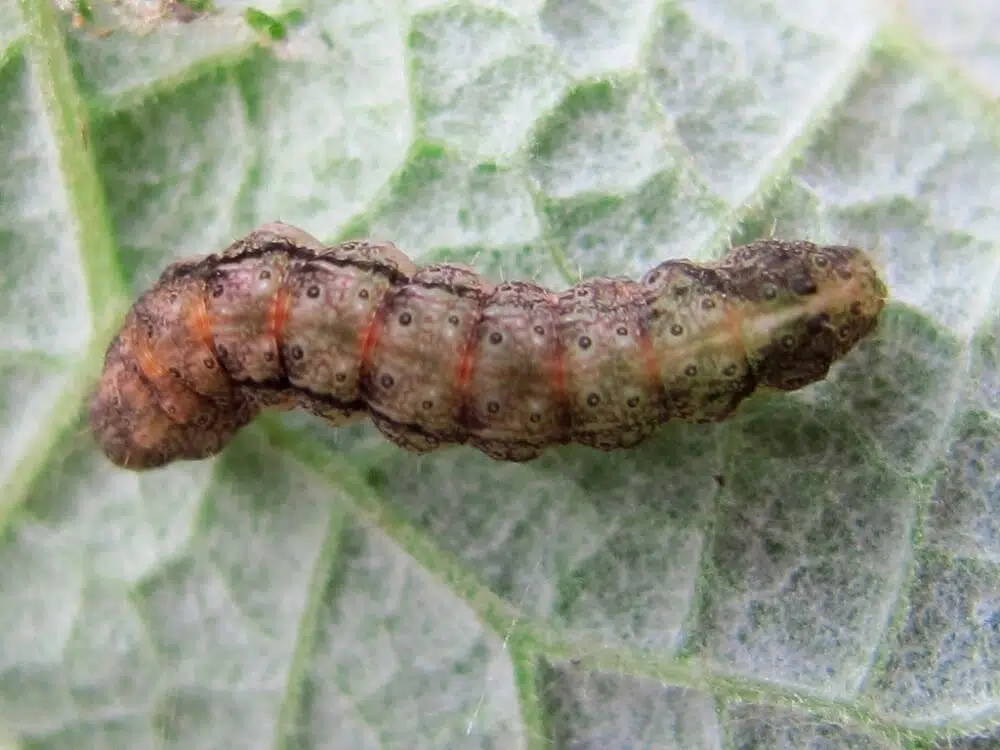
Brown is also the main color of the Ambiguous Moth and the Ambiguous Moth caterpillar (Lascoria ambigualis).
This species is seen in 2 to 3 broods across various US states.
It lives in gardens, parks, and woodlands, as well as at low to medium elevations.
The species is seen on flowers and shrubs the most.
Asters are among the most common flowers on where this brown caterpillar is seen on.
Blueberries also provide a good host for the species. The caterpillar is a common blueberry pest.
30. Nessus Sphinx Caterpillar
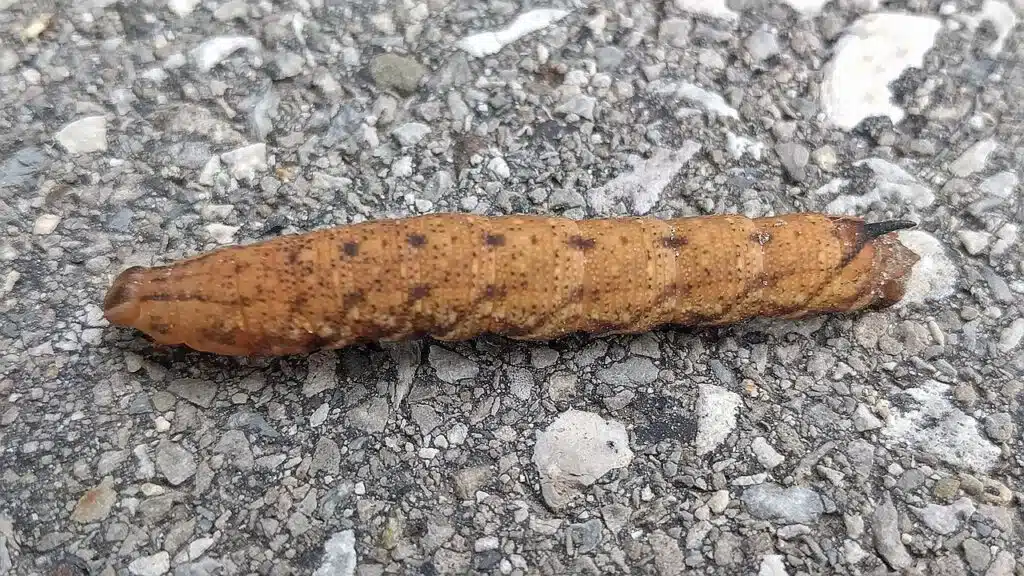
A combination of dark brown and black colors makes the Nessus Sphinx caterpillar (Amphion floridensis) difficult to spot.
This species of caterpillars are found across the United States.
It has a negative impact on vines and grapes.
Easily confused with dead twigs, this species has just a few natural predators.
Its most impactful role in the ecosystem is in its caterpillar stage.
Adult moths feed on the nectar of various plants and flowers. Common lilac is the species the adults feed on the most.
31. Red-fringed Emerald Caterpillar
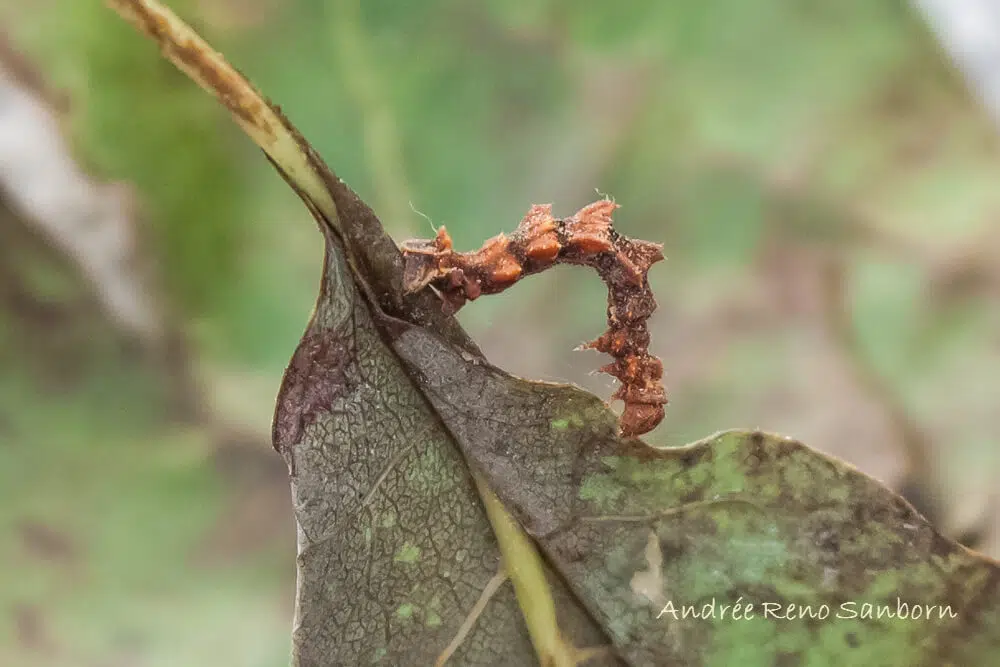
This dark brown caterpillar (Nemoria bistriaria) is common on various hardwood trees native to North America.
White oak is the prevalent host for the caterpillar. Found in parks and woodlands, these trees can be considerably impacted by the caterpillar.
To a lesser extent, the Red-fringed Emerald caterpillar is also known for using walnut and birch as species.
Common in the Eastern states, Red-fringed Emerald caterpillars are seen on the Eastern black walnut.
32. Achemon Sphinx Caterpillar
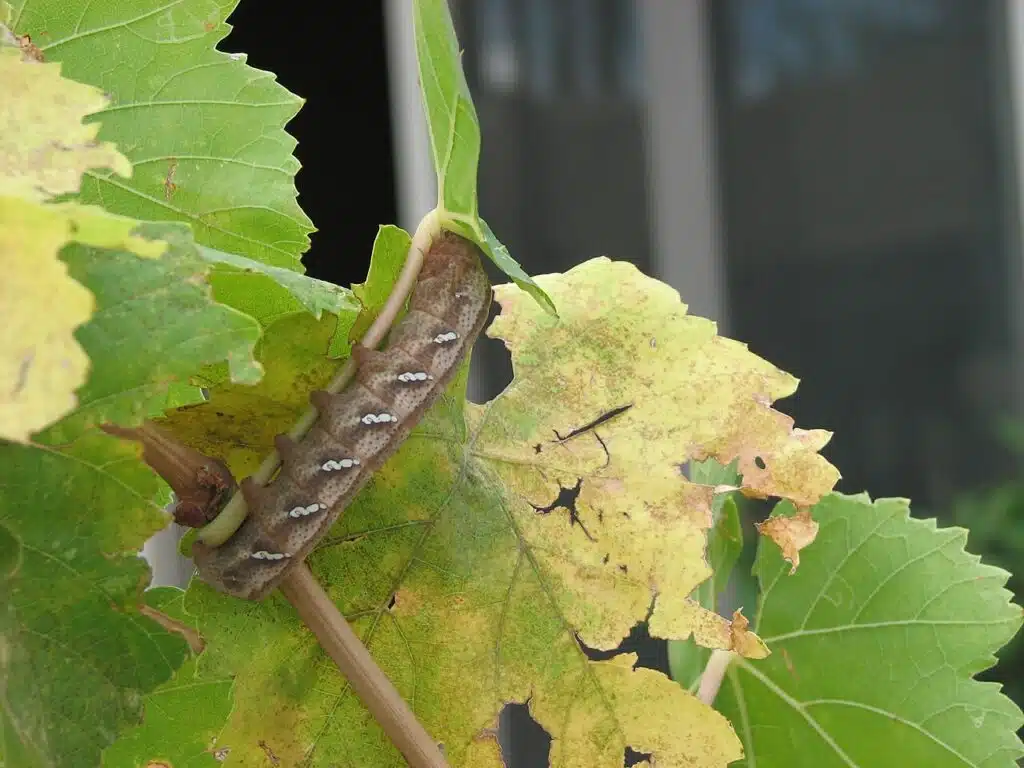
These caterpillars (Eumorpha achemon) go through various color changes as they move instars.
They begin life as green caterpillars and eventually turn brown.
Achemon Sphinx caterpillars are also known for showing multiple types of white spots across the body, similar to eyespots.
The camouflaging coloring of the caterpillars allows them to remain undetected by their hosts.
Grape vines are among the most common hosts for the species.
You can see Achemon Sphinx caterpillars up until August in states such as Texas and Florida.
33. Exposed Bird Dropping Moth Caterpillar
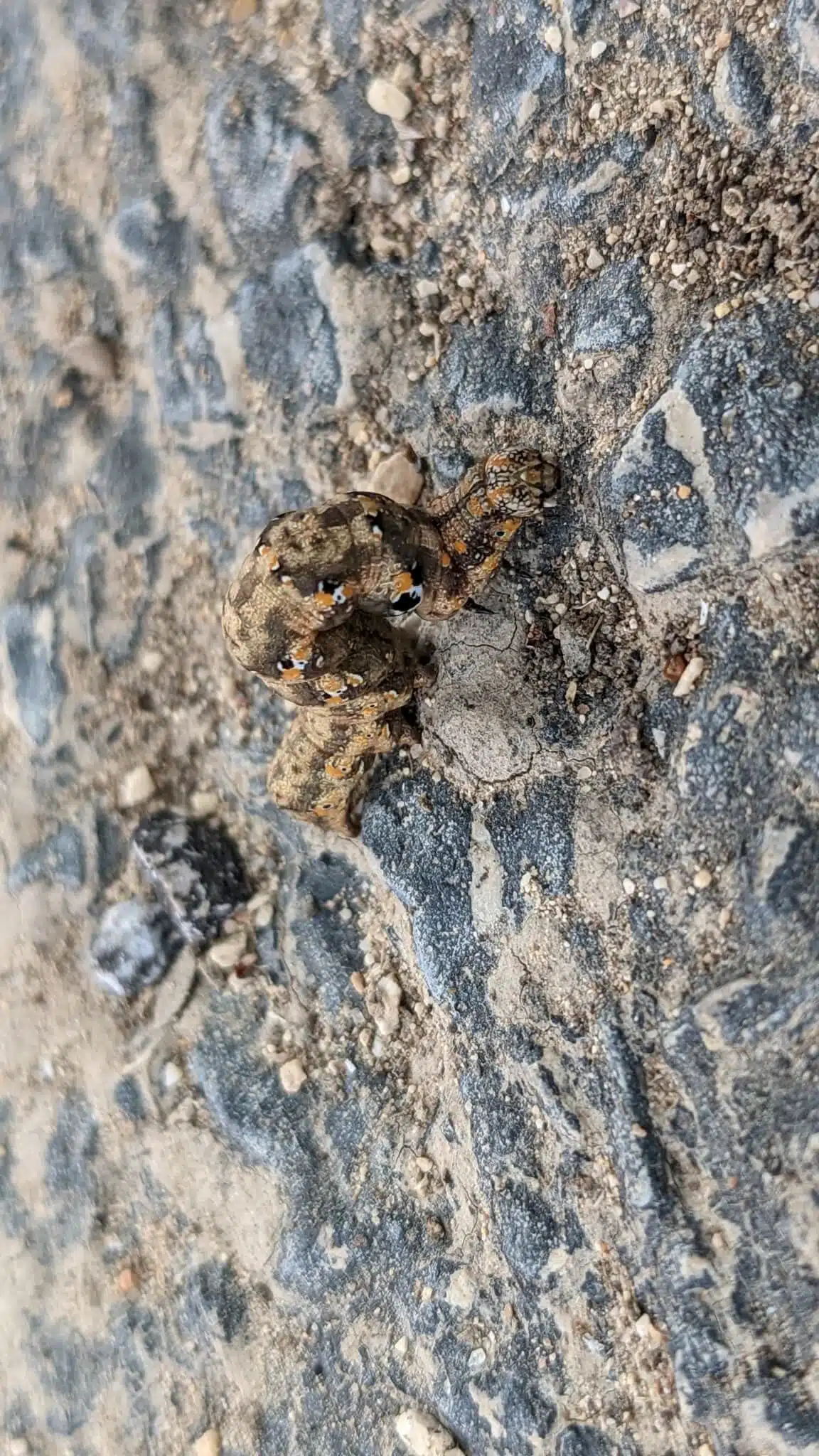
These caterpillars (Tarache aprica) are mostly seen in Eastern and Southeastern North American habitats.
You can find them even in Canada around Quebec and on the East Coast down to Florida.
The active season for the species is considerably shorter in the North.
The species is mostly active until August in the Northern states.
A longer season that starts in March and ends in the fall is specific to the species in Southern states.
Brown and cream colors are specific to the species. The color combinations make the species similar to bird droppings.
These colors are somewhat similar to the colors and nuances of the adult moth.
Caterpillars of the species are on the flight until early fall. They feed on the flowers and leaves of hollyhocks.
34. Ruby Tiger Moth Caterpillar
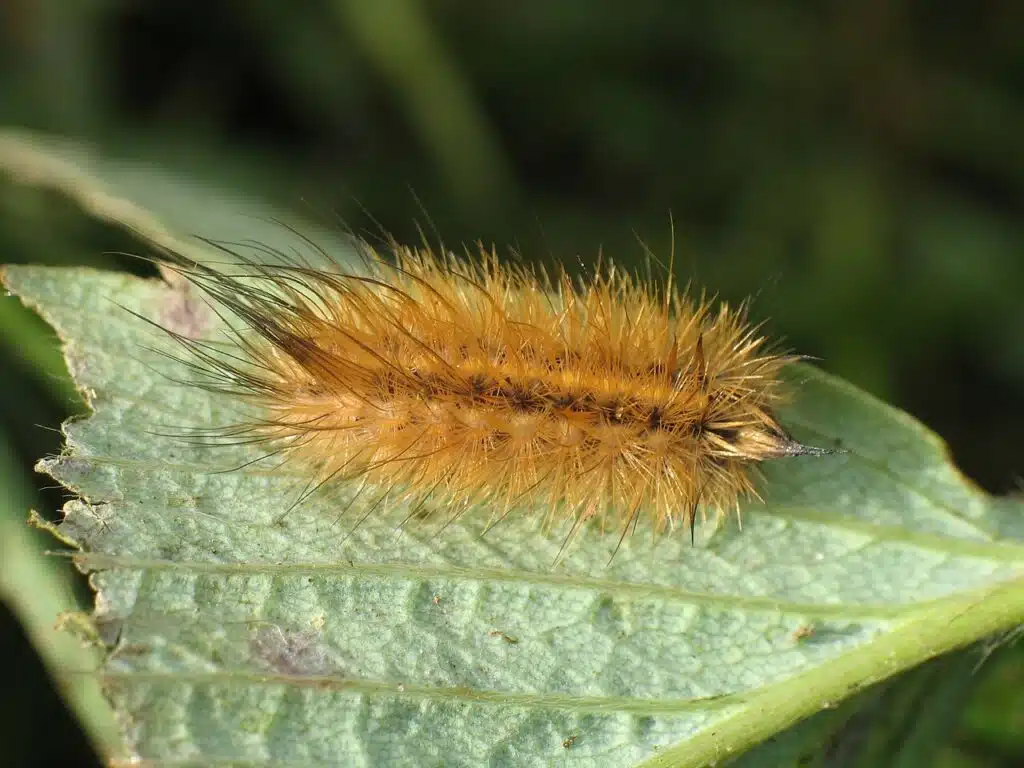
Ruby Tiger Moth caterpillars (Phragmatobia fuliginosa) are among the few brown species that also have long brown hairs across the body.
Downland and woodlands are among the most common habitats for the species.
Ruby Tiger Moth caterpillars have a preference towards moist habitats.
These caterpillars are pests of blackberries and prunes. However, they are also seen on a wide range of plants such as bog-rosemary.
There are anywhere between 1 and 3 generations of Ruby Tiger Moth caterpillars per year, depending on their region.
European Ruby Tiger Moth caterpillars only appear once per year, in June.
The species has up to 3 broods per year in North America.
It has a season that begins in April and ends in September across warmer US states.